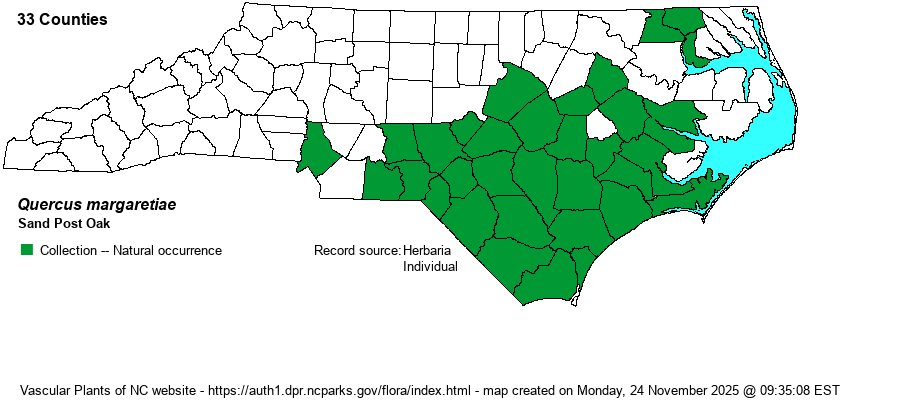| Author | Ashe ex Small | |
| Distribution | Occurs nearly throughout the southern two-thirds of the Coastal Plain, but very spottily distributed in the northern third, and probably absent from many counties there, especially north and south of Albemarle Sound. Barely present into the extreme southeastern Piedmont, west to Anson County and disjunctly to Mecklenburg County.
This is a Southern species, limited mainly to the Coastal Plain from southeastern VA to central FL, and west to most of OK and central TX.
| |
| Abundance | Common and easily found in the Longleaf Pine (Pinus palustris) belt from the Sandhills region east to Craven and Carteret counties. However, generally uncommon and more local in the central counties, and very rare in the northern third, limited mainly to the Chowan Sand Ridge (Gates and Chowan counties). | |
| Habitat | This is a species of dry, sandy soil, but the driest and most xeric soils are favored by Turkey Oak (Q. laevis); instead, it is often found with Bluejack Oak (Q. incana) on somewhat loamy or somewhat less xeric soil. All three oaks are seen primarily under Longleaf Pines, in classic sandhill habitats. |
| Phenology | Flowers in April, and fruits from September to November of the same year. | |
| Identification | This is a small deciduous tree, rarely to mid-size, growing mainly to 40 feet or rarely 50 feet tall. It is always an understory tree in Longleaf Pine stands. As the common name implies, the leaves resemble the taller and better known Post Oak (Q. stellata). However, Sand Post Oak leaves are smaller, only about 3-4 inches long, and barely 2 inches wide; the lobes are more rounded than the somewhat square side lobes on Post Oak. Thus, the leaf shape looks a bit more like a small White Oak (Q. alba), which does not grow in sandy soil, in “stunted” form, beneath Longleaf Pines. As Post Oak can at times grow in quite sandy soil, inexperienced people can confuse the two. The latter has quite hairy/tomentose twigs, whereas Sand Post Oak twigs are typically smooth. | |
| Taxonomic Comments | Only a very few references fail to consider this as a valid species. The main issue is the spelling of the specific name/epithet: RAB (1968) and some spelled it as “margaretta”, some as “margarettiae”, but most recent references spell it as “margarettae”. Weakley and Poindexter (2020 in press) discuss the reasoning for the use of "margaretiae".
| |
| Other Common Name(s) | Scrub Post Oak, Scrubby Post Oak, Dwarf Post Oak | |
| State Rank | S4 [S4S5] | |
| Global Rank | G5 | |
| State Status | | |
| US Status | | |
| USACE-agcp | | |
| USACE-emp | | |

